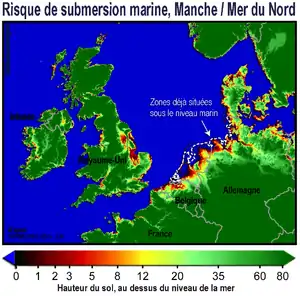Climate change in Belgium
Climate change in Belgium describes the global warming related issues in Belgium.


Emissions
.png.webp)
In 1990, the greenhouse gas (GHG) emissions were 146.9 million tons of CO
2 equivalent (Mt CO
2 eq), whose 88 Mt came from the Flemish Region, 54.8 Mt from the Walloon Region and 4 Mt from the Brussels-capital Region.[1]
Agreements
Being a member of the European Union, Belgium, applied the European Union Emission Trading Scheme set up by the Directive 2003/87/EC. The Kyoto protocol sets a 7.5% reduction of greenhouse gas emission target compared to 1990. Belgium set up a National Allocation Plan at the federal level with target for each of the three regions.
On 14 November 2002, Belgium signed the Cooperation Agreement for the implementation of a National Climate Plan and reporting in the context of the UNFCCC and the Kyoto protocol. The first National Allocation Plan was for the period from 2005 to 2007. The European commission approved it on 20 October 2004. The second allocation plan was for the period 2008-2012 and aims a reduction of 7.5% of greenhouse gas emissions compared to 1990.
Flemish Region
The target of the Flemish Region is a reduction of 5.2% of GHG in the period 2008-2012 compared to 1990. That means average emissions of 83.4 million tons CO
2 equivalent in the 2008-2012 period. The
2008-2012, Flemish allocation plan deals with installation consuming more than 0.5 PJ (139 GWh) annually.[1] 17% of GHG emissions comes from transportation and 21 from electricity production and heat production (excluded heat for buildings).[1] There are 178 installations listed.
The largest emitters are, with their emissions in tons of CO
2 equivalent (t CO
2 eq) per year:[1]
- Sidmar owned by ArcelorMittal in Ghent: 8,918,495
- Total refinery in Antwerp: 4,323,405
- BASF in Antwerp: 2,088,422
- Zandvliet Power, a joint venture of BASF and GDF Suez, in Zandvliet: 1,119,158
- Esso refinery in Antwerp: 1,933,000
- Fina Olefins in Antwerp: 1,414,550
- Electrabel in Herdersbrug: 990,397
- Electrabel in Drogenbos: 998,794
- E.ON Benelux in Vilvoorde: 828,920
- SPE in Ringvaarts: 807,066
- Electrabel in Ruien: 730,332
- E.ON Benelux in Langerloo: 586,961
- Degussa in Antwerp: 526,949
Brussels-Capital Region
Being a federal state, Brussels-Capital Region also made a second allocation plan for 2008–2012 based on the decree of June 3, 2004 that implements the European directive 2003/87/CE. In that plan, Brussels objective is to have an increase of maximum 3.475% of greenhouse gas emissions compared to 1990.
In 2004, the Brussels-Capital Region emitted 4.4 million tons CO
2 equivalent, an increase of 9% compared to 1990 when emissions were 4.083 Mt CO
2 eq. The emissions come from domestic use (45%), tertiary sector (25%) and transportation (19%), and energy/industry (2%).[1] The 4.4 Mt CO
2 eq do not take into account GHG emission due to electricity production outside the region.
The 2008–2012 allocation plans include only eight facilities:
- Audi (former Volkswagen plant) auto production plant in Forest
- a BNP Paribas facility (former Fortis)
- Bruda plant producing Asphalt
- Electrabel turbo-jet power plant in Schaarbeek
- Electrabel turbo-jet power plant at Buda
- Electrabel turbo-jet power plant owned at Volta
- an RTBF television facility
- World Trade Center building
Walloon Region
In the second allocation plan (for the period 2008-2012), the Walloon Region is planning a reduction of 7.5% of GHG emissions compared to 1990 when 54.84 million tons CO
2 equivalent was emitted.
[1]
The plan for 2008-2012 includes 172 premises. In 2005, the largest emitters were (number in tons CO
2 equivalent per year):[1]
- CCB cement plant in Gaurain-Ramecroix: 1,515,543
- Holcim cement plant in Obourg: 1,508,060
- Electrabel power plant in Monceau: 1,260,520
- CBR cement plant in Lixhe: 1,059,929
- Dumont Wautier Lime plant in Saint Georges: 1,294,087
Other large emitter are cast iron and steel producer in Charleroi and Liège.
On October 22, 2009, BASF announced that they will close the plant located at Feluy at the end of 2009.[2] That plant had a yearly allocation of 36,688 tons of CO
2 equivalent.
References
- Federal Public Service of Public Health, Food Chain Safety and Environment (September 2006). Draft of Belgian National Allocation Plan for CO2-emission allowances 2008-2012 (PDF). Brussels. Archived (PDF) from the original on 2010-07-27.
- "BASF annonce la fermeture de son usine de Feluy". www.7sur7.be. Archived from the original on 2011-09-29.